Practical Ways to Efficiently Drain a Bathtub
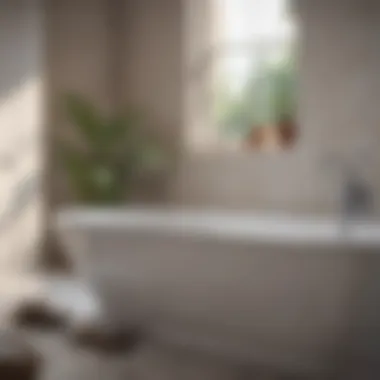
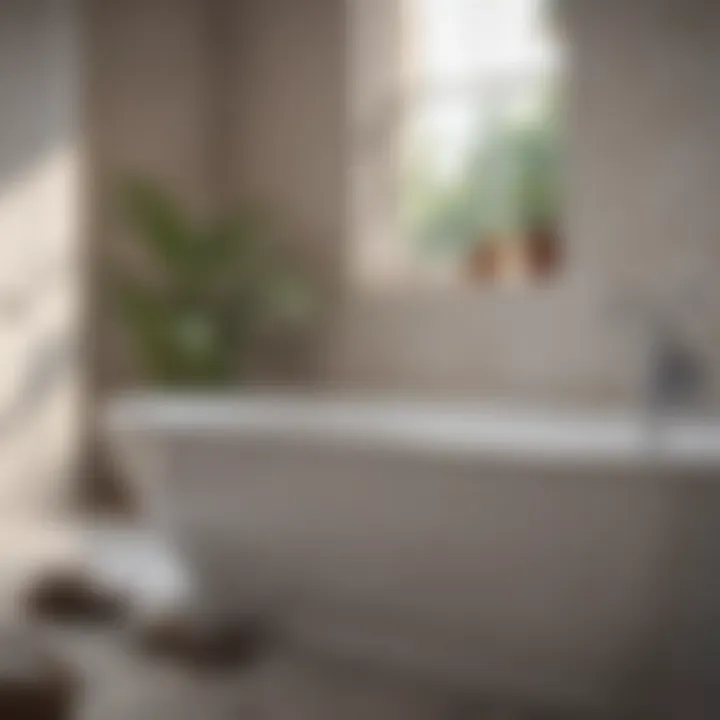
Intro
Design Inspiration
When it comes to refreshing the aesthetics of a bathroom, the way water flows—or rather, how it drains—plays a pivotal role. A well-draining bathtub contributes not only to functionality but also to the overall look and feel of your bathing space.
Trending Styles
Currently, various design trends influence how bathtubs are placed and integrated into spaces. Many homeowners lean towards minimalist designs, focusing on sleek lines and simplicity. Some even opt for freestanding tubs, which add an air of sophistication. However, regardless of style, ensuring a proper drainage system must be considered during the design phase to avoid future headaches.
Every design choice, from materials to shapes, should prioritize efficient drainage.
Color Palettes
While you might not instinctively correlate colors with drainage, the aesthetic appeal can influence how you perceive maintenance challenges. Opting for darker color palettes can sometimes mask minor wear and tear in high-use areas, while lighter colors may highlight issues. Make sure your color choices align with a practical draining solution to maintain both beauty and cleanliness in your bathroom.
Practical Tips
Maintenance & Care
Regular maintenance goes a long way in keeping your bathtub draining smoothly. Here are some practical tips to simplify your upkeep:
- Regularly Clean the Drain: Hair and soap chunks can build up over time, so it’s always good to check your drains periodically.
- Use Natural Cleaners: A mixture of baking soda and vinegar can help break down some of those stubborn clogs without harmful chemicals.
- Watch What Goes Down the Tub: Avoid sending down thick substances or excess hair; consider using a drain cover for extra protection.
Budgeting & Planning
When planning for a kitchen or bathroom renovation, budgeting for proper drainage systems is essential. You wouldn't want to penny-pinch on a crucial element like a quality drain just to save a few bucks. Quality bathtubs and their draining systems can prevent significant costs down the line associated with repairs or replacements.
- Research Options: Dive into specific bathtub models known for their effective draining features. Do your homework on brands like Kohler or Delta, often regarded for doing the job right.
- Consider Professional Help: Engaging a plumber during your renovation can be an investment that saves you headaches later.
"An efficiently draining bathtub isn’t just about water management; it’s about how well the design integrates with function."
Understanding Bathtub Drainage Systems
In any home with a bathtub, understanding how the drainage system works is crucial. It helps in identifying potential problems before they spiral out of control. A well-functioning bathtub drainage system can prevent water damage and unpleasant odors, enhancing the overall bathing experience.
Overview of Bathtub Mechanics
Bathtub mechanics may seem straightforward, but they involve a combination of components that work harmoniously to ensure proper drainage. When you pull the lever or push the stopper, the water is directed down the drain pipe, allowing it to exit efficiently.
Understanding how these mechanics function can be critical for homeowners. For example, when the bathtub refuses to drain properly, knowing the basics of how water travels will help in troubleshooting the issue effectively.
Additionally, knowing about your bathtub's mechanics can save a great deal of hassle and money when it comes to maintenance. It empowers you to quickly diagnose minor issues, such as a blocked pipe or a defective stopper, before needing to call in a professional.
Different Types of Bathtub Drains
Not all bathtubs are created equal, especially when it comes to their drainage systems. There are several styles of drains, and each comes with its own set of features and benefits. Here’s a deeper dive into the types you might encounter:
Pop-up drain
The pop-up drain is quite common in modern bathtubs. This type works with a simple mechanism that allows you to easily plug or unblock the drain with a lift or push action.
One of its key characteristics is the ease with which it can be operated. The pop-up mechanism allows for a quick shut-off and drainage, making it a beneficial choice, particularly in busy households.
However, while pop-up drains are very user-friendly, they can also be prone to malfunction, often becoming stuck or not sealing properly. It can be frustrating to deal with, yet regular maintenance can ward off most issues.
Lift-and-turn drain
Next is the lift-and-turn drain, generally preferred for its sleek appearance and low profile. This style is operated by lifting and turning the knob on the drain cover, making it simple to engage and disengage.
One notable aspect of this drain is its design, which is minimal and aesthetically pleasing. It suits various interior styles and is often found in modern bathrooms. However, some homeowners may find the mechanism a tad cumbersome compared to the pop-up drain at times, leading to potential wear and tear that might require periodic checking.
Trip lever drain
The trip lever drain features a lever mounted on the side of the bath, which operates a stopper at the bottom. You pull the lever, and the stopper opens or closes without needing to reach down into the tub.
It's highly regarded for its ease of use, particularly for those who may find bending down challenging. This design can be quite advantageous, especially for elderly individuals or those with mobility issues. Nonetheless, the trip lever mechanism requires occasional adjustments and check-ups, as alignment issues might arise over time.
Understanding the different types of drains is vital in troubleshooting and maintaining your bathtub's drainage system.
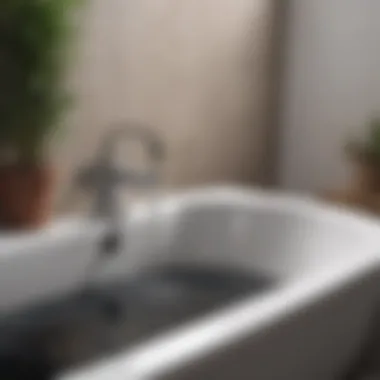
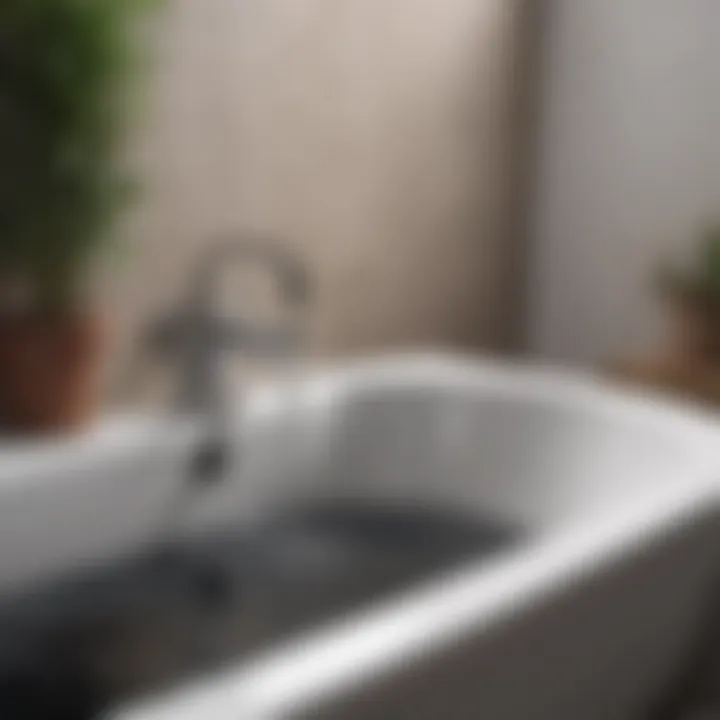
Each type of drain has its unique pros and cons, but with the right knowledge, you can determine which best fits your lifestyle and needs. By familiarizing yourself with these drainage systems, you are well on your way to ensuring that your bathtub functions flawlessly.
Preparing for the Draining Process
Preparing to drain your bathtub is not just about rolling up your sleeves and getting right to it. It's all about laying the groundwork for an efficient and hassle-free experience. Proper preparation can save time, minimize mess, and reduce the risk of complications later on. This crucial step ensures that when you finally get to draining the tub, everything else runs smoothly.
Essential Tools Required
Before you dive headfirst into the task, it’s imperative to gather the essential tools that will aid in the draining process. Having the right equipment at your fingertips streamlines the effort.
Wrench
The wrench is indispensable when it comes to bathtub drainage. This handy tool is designed to grip and turn nuts and bolts, which are quite common in drain assembly. Its key characteristic lies in its versatility; whether you are tightening or loosening connectors, the wrench comes in handy. The unique feature of an adjustable wrench is that it can fit multiple sizes of nuts. This is particularly beneficial, considering the varied fittings in drainage systems. However, caution is required; if misused, it can strip the fittings, causing more headaches than help.
Screwdriver
When discussing essential tools, the screwdriver can't be overlooked. It's typically used for removing screws that hold various components of the drain in place. The key characteristic of a flathead or Phillips screwdriver is its ability to adapt to different screw types, making it a crucial addition to your toolbox. One unique feature worth noting is the magnetic tip available on some screwdrivers, which can hold screws in place, preventing dropping them into the abyss of the drain. But care must be taken, as improper use can lead to stripped screws, complicating your situation.
Bucket
A bucket may seem mundane, but it serves a very important role during the draining process. Used to catch any residual water, the key characteristic of a sturdy bucket is its ample capacity, which can accommodate the leftover water in most bathtubs. The unique feature of a lightweight plastic model makes it easier to lift and maneuver. Despite its straightforward use, a bucket's downside is that it may need frequent emptying if the remaining water volume is significant. Still, it provides a simple way to maintain cleanliness during what can be a messy task.
Safety Precautions
It’s important never to skip on safety when preparing to drain a bathtub. Taking precautions not only protects you but also averts potential damage to your home.
Turning off water supply
Turning off the water supply is the first order of business. This step is crucial because it stops any unexpected flooding while you’re working. The key characteristic of this precaution is the peace of mind it provides. By shutting off the water, you ensure that no additional water will pump into the tub during the draining process. A unique feature of most plumbing systems is that they provide valves located usually near the floor or at the water heater, easily accessible for quick operation. While generally straightforward, forgetting this step can lead to chaos, which is a headache you want to avoid.
Clearing the area
Clearing the area around the bathtub is essential before you get started. This not only increases your working space but also helps to avoid slips and falls on wet, cluttered floors. The key characteristic of this precaution is that it sets up an organized work environment. Removing unnecessary items ensures that all needed tools are within reach and that there’s no risk of damaging nearby furnishings. The unique feature here lies in the ability to mentally prepare for the task ahead; a tidy space can help in focusing better. However, this step might take a bit of time, depending on how cluttered the area is.
Wearing protective gear
Finally, wearing protective gear cannot be overstated. Items like gloves and goggles are your first line of defense against grime and potential injuries. The key characteristic of protective gear, particularly gloves, is that they keep harmful bacteria at bay while also protecting your skin from harsh cleaning chemicals. The unique feature of using goggles is that they guard against splashes when handling water or drain cleaning solutions. While it might seem a bit over the top, these small measures can save you from larger mishaps down the line.
Draining Methods
When it comes to keeping your bathtub functioning at its best, understanding the techniques for draining it effectively is indispensable. Every homeowner has faced clogged or slow drains at some point, and knowing the ropes on how to handle these situations can save time, money, and a fair bit of frustration. In this section, we dive into various methods to drain a bathtub, breaking down practical techniques and tools that simplify the task while ensuring your plumbing maintains its integrity.
Manual Draining Techniques
Using a siphon
Using a siphon for draining your bathtub is not just an old wives' tale. This method leverages the principles of fluid dynamics, allowing you to draw water from the tub without any heavy lifting. The key characteristic of a siphon setup is its simple yet effective way to relocate water downhill through a tube. It's a beneficial choice because it requires minimal tools: just a length of hose, which you can rig from your local hardware store.
A unique feature of utilizing a siphon is that you don’t need electrical power. The only downside? It can require a bit of patience, as it might take a while to get things flowing, especially if the tube is very long or kinked.
Using a bucket
When it comes to the classics, nothing beats the effectiveness of using a bucket to manually drain water from your bathtub. It's straightforward—just fill up the bucket and pour it out outside. The simplicity of this method is its primary advantage. The key characteristic is its accessibility; everyone has a bucket lying around somewhere, right?
This method is popular for the control it offers—you can decide exactly how and when to dump the water. However, a bucket does come with some disadvantages. For larger volumes of water, it's labor-intensive and could take multiple trips back and forth, which can be quite a workout!
Employing a wet/dry vacuum
For those who enjoy having a few power tools in their arsenal, a wet/dry vacuum can be quite the ally in draining a bathtub. This method is characterized by its speed and efficiency, as it can quickly suck up a significant body of water with little effort on your part.
Utilizing this tool is a beneficial choice because it can tackle not just the water but also some light debris, clearing out potential sources of clogs. The unique feature here is versatility; many wet/dry vacuums come with attachments that can get into tight spaces.
However, there are downsides to consider. If you do not have one readily available, purchasing a high-quality vacuum can be an investment. Plus, if the amount of water is too much, it could overwhelm your vacuum's capacity.
Utilizing the Drain Mechanism
When your bathtub is equipped with a drainage mechanism, knowing how to use it can be both an effective and efficient way to drain water swiftly. Each type of drain has its own mechanism—be it a pop-up, lift-and-turn, or trip lever. Understanding how to manipulate these can prevent water from backing up.
For example, a pop-up drain is usually activated by a simple pull lever or knob, allowing for quick drainage with just a flick of your wrist. Familiarity with your particular drain type can make all the difference in how smoothly your draining procedures go.
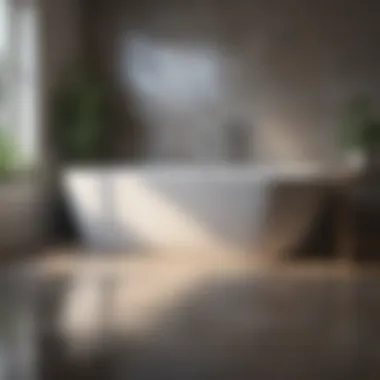

Using Plumbing Tools
Drain snake
When talk turns to drain cleaning, many homeowners nod knowingly at the mention of a drain snake. This handy tool is essentially a long, flexible auger that can wind around bends to remove clogs lodged in pipes. The key characteristic of a drain snake is its simple yet effective design, which works without electricity.
It’s a popular choice among DIYers because it often tackles the deeper obstructions that standard methods miss. Its unique feature is how adaptable it is—some models can even have interchangeable heads, depending on the level of clogging you’re facing. The disadvantage? It might require some expertise to use effectively without damaging your pipes.
Plumber’s auger
Many turn to the plumber’s auger when the situation calls for a more powerful approach. This tool has a corkscrew-like mechanism that can penetrate deeply into a blocked drain, effectively cutting through stubborn clogs made of hair, soap, or even tree roots. Its key characteristic is that it can reach farther than a standard drain snake.
A plumber’s auger is a fantastic choice for those who encounter consistent drainage issues, as it’s designed for heavy-duty problems. The unique feature of this tool is its robustness, but bear in mind that it can be bulky and may require a bit of practice to wield properly.
Now that you have a grasp of these draining methods, it’s crucial to assess which approach suits your particular situation before diving deeper into troubleshooting and potential maintenance solutions.
Troubleshooting Common Drain Issues
When it comes to maintaining a bathtub, understanding troublesome drain issues plays a crucial role in ensuring a smooth and functional experience. Many homeowners encounter these pesky predicaments, often leading to frustration and even expensive repairs. By recognizing and addressing problems early on, it’s possible to extend the life of your tub and keep it in prime condition. In this section, we will delve into the common drain issues you may face and how to troubleshoot them effectively.
Identifying Clogs
Identifying the source of clogs can save you from a world of hurt. Knowing what typically causes blockages enables you to take preventive measures. Let’s dive into the three main culprits of clogs in bathtubs.
Hair clogs
One of the most frequent offenders, hair clogs, can lead to significant drainage issues. Hair strands tend to intertwine with soap and other debris, creating a nasty mess that accumulates over time. Digging deep into this problem reveals that hair clogs often form gradually, making them tricky to spot until it’s too late.
The key characteristic here is that hair doesn’t simply wash away; it sticks around. For homeowners, this aspect makes hair clogs a common yet largely avoidable issue if caught early. Using a drain screen is one way to keep this problem at bay, preventing hair from entering the drain in the first place.
However, once they occur, hair clogs can be a hassle to remove, requiring tools like a drain snake or even professional assistance to clear them.
Soapy residue
Soapy residue is another troublemaker. It tends to cling to the walls of the pipes over time, combining with hair and other organic material to create a slippery but effective barrier against water flow. As this residue builds up, tub drainage can slow considerably, leading to stagnant water and an unpleasant bathing experience.
The unique feature of soapy residue is that it's often overlooked, as it doesn’t present an immediate visual cue. As the residue develops gradually, it may seem harmless initially. Nonetheless, if left unchecked, it can create a formidable blockade. Regular cleaning and the use of natural remedies, like vinegar, can help break down this residue before it becomes a problem.
Foreign objects
Lastly, foreign objects often contribute to unexpected drain issues. Things like kids’ toys, cotton swabs, and even a fallen washcloth can bring draining to a halt. The defining feature of foreign objects is their unpredictability; you never know what might accidentally slip down the drain.
While these objects may seem inconsequential, they can cause substantial blockages quickly. Checking for visible clogs or using a drain snake can provide insights on how to clear these unwanted items.
Dealing with Slow Drains
Slow drains often signal underlying issues. Homeowners should be wary of this common issue. Regular maintenance and periodic checks can help you avoid a full-blown clog. If you find yourself waiting for water to drain, examine the lower parts of the pipes.
Utilizing a mixture of baking soda and vinegar can sometimes provide relief, allowing you to dissolve minor buildups before they escalate. Additionally, twice-a-year maintenance checks can save you headaches down the line, helping keep your tub and its plumbing functioning effectively.
Resolving Complete Blockages
When you face a complete blockage, it’s time to call in the big guns. This issue generally arises when a combination of problems has gone unchecked, and drastic measures are necessary. If plunging doesn’t work and you still have standing water, you might have to take more invasive actions.
Identifying the blockage and visualizing where it occurs in the plumbing system is essential. Using a drain snake or auger may be necessary to break up or remove whatever is clogging your drain. In more serious cases, consulting a professional may be warranted to diagnose intricate plumbing issues that could be out of your hands.
Remember: Prevention is always better than a cure. Regular checks and maintenance can save you time and money.
Post-Draining Maintenance
Maintaining a clean and functioning bathtub drain is essential for ensuring that your bathing experience remains pleasant and problem-free. Once the draining process is complete, there are several maintenace steps that can prevent future issues, saving you from unexpected hassles down the line.
Cleaning the Drain
Cleaning the drain after draining the bathtub helps to eliminate any residual waste or buildup that could lead to clogs later. Grime, hair, and soap residue tend to accumulate over time, and neglecting to clean these out can eventually slow down the draining process again. Regular cleaning also helps to maintain hygienic conditions in the bathroom.
Using a simple solution of vinegar and baking soda can be effective. Pour half a cup of baking soda followed by half a cup of vinegar down the drain. After waiting for about 30 minutes, flush it with hot water. This homemade method not only helps clean the drain but also keeps it fresh-smelling and free of bacteria.
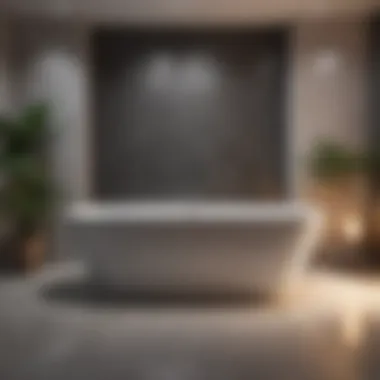

Preventive Measures for Future Clogs
Taking preventive measures can save you from the headache of dealing with stubborn clogs in the future. Here are several strategies worth considering:
Regular cleaning routines
Routine cleaning of your bathtub drain is a proactive step that every homeowner should consider. Setting a fixed schedule—be it bi-weekly or monthly—can dramatically reduce the risk of a buildup in the first place. The key characteristic of a regular routine lies in its consistency. Performing this cleaning task repeatedly makes it a simple and easy choice, ensuring you keep your drains clear.
Benefits of this type of maintenance are numerous: it promotes a cleaner environment, prolongs the life of your plumbing, and ultimately saves you money on expensive repairs. Resisting this effort could lead to serious plumbing headaches in future—which is often a trade that doesn't sit well with many.
Using drain screens
Installing drain screens is a simple yet effective preventive measure against clogs. These screens catch hair and larger debris before they enter the plumbing system, significantly minimizing the chance of blockages. The key aspect of drain screens is their low-maintenance requirement. They're functional and easy to use, making them a popular choice for homeowners aiming for hassle-free upkeep.
However, they do require occasional cleaning to remain effective. Over time, with debris accumulation, a clogged screen can hinder water flow. Remember to remove and clean them regularly to maximize their effectiveness.
Educating household members
Engaging your family when it comes to drain habits is crucial. By educating household members on best practices, such as removing hair from the tub after use or using soap sparingly, you can foster a collective sense of responsibility. The unique feature here is the communal effort. This way, everyone in the household contributes to keeping the drain clean, rather than placing the entire onus on just one individual.
Discussions about proper disposal of items such as wipes or cotton balls can also go a long way. This preventive measure not only promotes awareness but also strengthens family bonds through shared goals.
"It's easier to tackle potential problems as a team than to face them head-on when they arise individually."
Together, cleaning the drain regularly, using screens, and educating others can provide a multi-faceted approach to maintaining your bathtub drainage system. These strategies work hand-in-hand, ensuring you enjoy your bathtub without the fear of blocked drains and unwanted complications.
When to Call a Professional
Understanding when to call a professional for bathtub drainage issues is a vital aspect that many homeowners overlook. Sometimes, despite our best efforts and the use of various tools, the stubborn nature of drain problems can lead to frustration. Knowing when your DIY attempts should hand over to an expert can save time, resources, and headaches down the road.
Hiring a professional plumber can not only ensure that the job is done correctly but also help to identify underlying issues that may not be apparent at first glance. Problems related to drainage can often have deep-rooted causes within the plumbing system, which require a keen eye and specialized training to diagnose. Having a certified plumber handle the situation brings several benefits, including personalized advice and effective solutions tailored to your specific needs, potentially avoiding costly repairs in the future.
Signs Indicating Serious Drain Problems
Persistent backflow
Persistent backflow in your bathtub can be a troublesome issue. It happens when water that should flow down the drain reverses direction, causing unpleasant pooling or flooding. The problem can stem from clogged pipes or issues in the main sewer line.
This characteristic makes persistent backflow a sign that something is seriously amiss within your drainage system. If you notice this happening frequently, it often indicates a backlog of dirty water from the main line pushing back into your pipes. Leaving such an issue unaddressed can lead to major damage and health hazards, as it may encourage bacteria growth or cause water leaks into walls. This could be a clear indicator that calling a professional is necessary.
Foul odors
Foul odors emanating from your bathtub are more than just an unpleasant nuisance—they can be indicative of deeper problems in your plumbing. Such smells often arise from stagnated water or decaying organic matter trapped somewhere in the drains. When the smell wafts up, it can signify a break in the trap or perhaps even mold growth in hidden places.
Proper ventilation is key for maintaining a pleasant bathroom atmosphere. Ignoring foul odors can mean risking the health of your household, especially if the source is a blocked vent or sewer line that could spill toxic substances. If there’s no quick fix, it's wise to reach out to a qualified plumber for a comprehensive examination.
Discoloration of water
Another telltale sign of trouble could be discoloration of water in your bathtub. When the water is cloudy, brown, or has an unusual hue, it might suggest that rust or debris from old pipes is leaching into your water supply. This specific aspect could directly affect your bathing experience and also pose health risks. The last thing anyone wants is to expose themselves to dirty water—especially when their intent was to enjoy a soothing bath.
Understanding these signs of potential plumbing failure encourages proactive measures. If such indicators appear and persist, contacting a certified professional should be one of your first steps.
Choosing a Certified Plumber
When the time comes to hire a plumber, it’s important to choose one that is certified and holds the proper licenses. With numerous plumbing services available, the difference between a certified professional and an inexperienced handyman is vast. A certified plumber guarantees that your bathtub drainage issues will be addressed skillfully and according to industry standards.
Look into customer reviews and ask for references. Resources like reddit.com can provide insight from local homeowners who have experienced the same issues. Furthermore, it’s a good practice to request quotes from multiple plumbers to ensure a fair price, while also verifying their credentials and experience in handling bathtub drainage repairs.
In choosing the right professional for your plumbing needs, you'll gain peace of mind as well as the assurance that your bathroom remains a safe, functional, and pleasant space.
Culmination
Summary of Key Points
Throughout the article, we examined several important elements:
- Understanding Drainage Systems: Recognizing how different drain types function sets the foundation for troubleshooting and maintenance.
- Preparation Matters: Equipping yourself with the right tools and safety precautions ensures a smoother draining process without unwelcome surprises.
- Effective Draining Techniques: From manual siphoning to utilizing plumbing tools, knowing various methods helps in tackling any draining scenario efficiently.
- Common Issues and Solutions: Identifying and resolving clogs or slow drains enhances your ability to keep the drainage system working optimally.
- Post-Draining Responsibility: Regular cleaning and preventive measures are vital for avoiding future drainage problems, ensuring longevity and functionality.
Final Recommendations
When it comes down to it, keep these pointers at the forefront of your mind:
- Regular Maintenance: Adopt a routine for cleaning your drains. Simple practices like occasionally running hot water or using drain screens can save a lot of hassle later on.
- Educate Family Members: Make sure everyone who's using the bathtub understands how to maintain the drainage system. This collective responsibility can minimize the risk of clogs.
- Act Quickly on Signs of Trouble: If you notice persistent backflow or weird smells, don’t wait to address them. The sooner you act, the better the outcome.
- Know When to Seek Help: Don’t hesitate to call a professional if issues seem beyond your capabilities. It’s often more economical in the long run to invest in expertise than to risk further damage.
Taking these measures leaves you well-equipped to deal with your bathtub's drainage system, making for a more pleasant environment in your home. Association with good routine and habits will not only improve your immediate situation but also serves your home well in the long haul.















